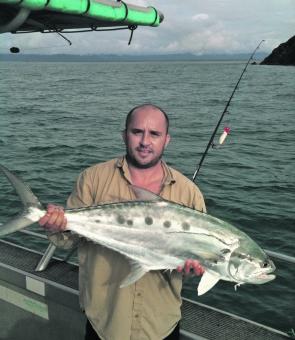As summer arrives, days on the water are a tad hot under the collar. As the temperature adjusts so must our fishing tactics to maximise our angling efforts. Low light periods become prime time and, if this coincides with a change in the tide, is when you’ll see your best results. This mind set can be executed in all forms of fishing.
We’re coming off the back of yet another great marlin season and the Lizard Island 7 day tournament statistics cemented the region as the best marlin fishery in the world. Overall, there were 158 strikes, with 119 hook-ups for 84 tags with 7 ‘granders’ amongst the mix.
As the days go by we are seeing the big fish and better numbers turn up late in the afternoon. There’s still a couple of weeks left of good marlin fishing and vessels will be fishing right to the day’s end to maximise their chances.
The same can be said about the light tackle scene with those last few hours of daylight really starting to see the ocean boil with pelagic activity. The tuna will bite all day but schools of Spanish mackerel and wahoo begin to relish when the sun begins to dip. Sometimes it’s impractical to be on the water too late in the afternoon because of the distances travelled to get home safely, but if you can manage an overnight trip when the conditions are right you’ll get to see a lot more activity.
The same applies for reef fishing, as solid day time catches will become tougher. A late afternoon fish for coral trout before night falls often sees these fish feed really well, especially in the deeper water. Follow this up with an overnight stay on the water and you will yield a far better result for your red species, such as nannygai, emperor and the hard fighting reef mangrove jacks.
Anchoring on or even drifting over rubbly ground will see the fish do their rounds and eventually come across your baits. The fishing tends to go in waves and they can come on the bite without warning. The norm is to have an explosive run with a flurry of fish coming over the side, then move on but return not too long later.
Bear in mind that the December period is the build up to the wet season and flash storms can whip up really quickly. Double check, and double check again, your forecast before embarking on such a trip. From personal experience, you don’t want to be caught up in a 30knot storm. Be very wary of those fronts that come from the west without warning.
Fishing up our local rivers and creeks can be long, hot work during the days, often resulting in few catches. Everything seems to go into a siesta, which is how we humans often feel when it is super warm.
You’ll definitely notice a big difference, especially at dawn, for your schooling fish such as queenfish, trevally and tarpon. You’ll tend to find them in the deeper holes, channels up stream and in the lower reaches across the shallow flats, river mouths and even along the beaches. Their movements are often quite visible and lure, fly and soft plastic fishing is a great way to attack these schools when they are at their optimum feeding time. Once the sun is well and truly up then they’ll then tend to shut shop. You are then best waiting for a late afternoon fish when your night feeders such as fingermark, grunter and mangrove jack do their best work and become really active.
Using fresh live baits such as garfish, mullet, sardines and squid are dynamite baits to entice a big bite from a big fish. Concentrate where there is plenty of solid structure, which can present its own challenges, but the rewards will be there. Sunken trees, steep mangrove edges, pylons, wharfs and rock walls all offer ideal holding offices for these predatory fish. At night these fish don’t muck around so have your drags well set and be ready for an ambush attack.
To be successful at this time of year, fish smarter and not necessarily harder. Stick to the cooler parts of the day.
Reads: 1112
Night feeders, like this fingermark, are best targeted late afternoon when they become really active.

You’ll tend to find queenfish in the deeper holes, channels up stream and in the lower reaches across the shallow flats, river mouths and even along the beaches as the water gets warmer throughout summer.




